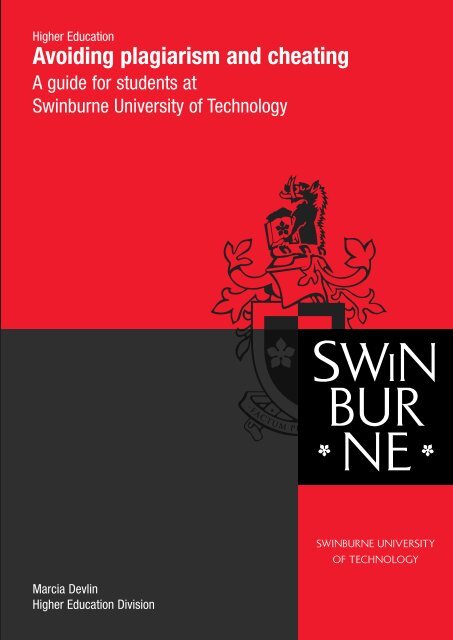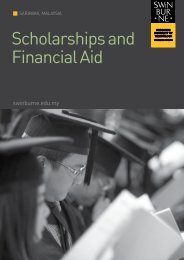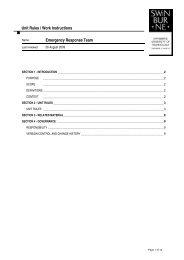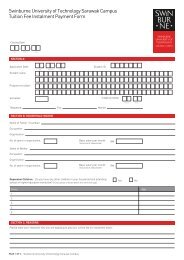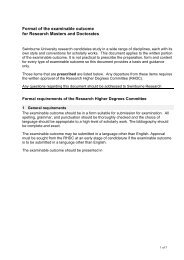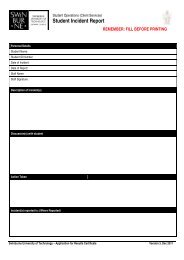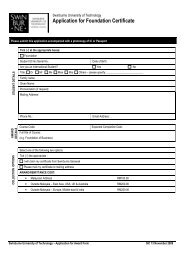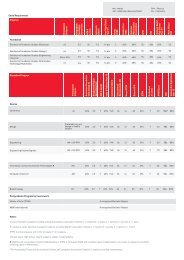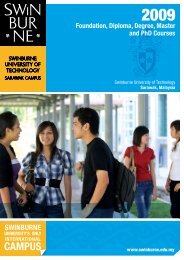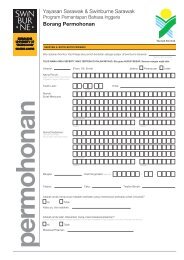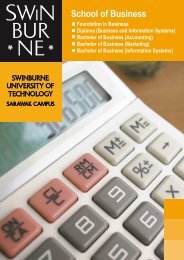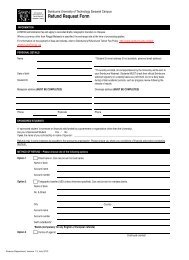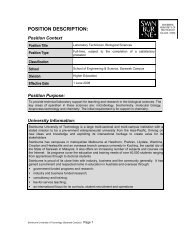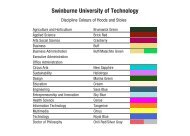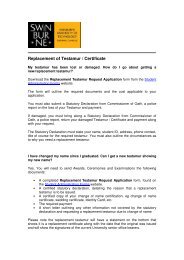Plagiarism Guide - Swinburne University of Technology
Plagiarism Guide - Swinburne University of Technology
Plagiarism Guide - Swinburne University of Technology
- No tags were found...
Create successful ePaper yourself
Turn your PDF publications into a flip-book with our unique Google optimized e-Paper software.
candidate gain knowledge about the PAO function and responsibilities <strong>of</strong> thepublic affairs <strong>of</strong>ficer. The specialty track is divided into three ratings: Technician,Senior, and Master. The specific requirements for each are discussed in thispamphlet. Training in this specialty track may be ideally accomplished under theguidance <strong>of</strong> a higher rated PAO mentor or completed independently.Training ObjectivesThe objectives for the Public Affairs Officer specialty track are to:• Develop a highly motivated and trained public affairs <strong>of</strong>ficer who willconduct and promote an effective program.• Perform the duties and tasks association with CAP’s squadron, group, wingand region PAO positions.• Possess a comprehensive knowledge <strong>of</strong> the Civil Air Patrol and the PAOprogram.• Each specialty track level contains Knowledge, Training, and PerformanceRequirements as well as Service Requirements that must be completed in orderto attain each successive rating. These requirements will vary as the candidateproceeds through the levels. These are completed through self-study, on-the-jobtraining (OJT) experiences, in-residence coursework and agreement with yourassigned OJT supervisor.• Knowledge Requirements are objectives describing what each candidate isexpected to know to attain the rating. An online or paper test is the primarymethod by which candidates demonstrate their knowledge <strong>of</strong> the material. Theexams are open-book with no time limit and the passing score is 80%.• Training Requirements are objectives that require the candidate to learnsystems and processes.• Performance Requirements are objectives describing what each candidateis expected to complete through active participation to attain the rating.• Service Requirements require that candidates serve in a certain area for aspecified amount <strong>of</strong> time to receive the rating. While not limiting the role thatcandidates may take as public affairs <strong>of</strong>ficers, it is suggested that the level <strong>of</strong>responsibility begin modestly and increase as the candidate advances.Guidance for On-the-Job Training (OJT) Supervisors and UnitCommandersThe OJT supervisor plays an important role in the success <strong>of</strong> the PAO in training.These senior member <strong>of</strong>ficers, in partnership with the unit’s commander, guide4 CAPP 201 25 JULY 2014
4 ■ Avoiding <strong>Plagiarism</strong> and Cheating
Avoiding plagiarism and cheatingA guide for students at <strong>Swinburne</strong> <strong>University</strong> <strong>of</strong> <strong>Technology</strong>This guide explains what is meant by plagiarism at <strong>Swinburne</strong> <strong>University</strong> <strong>of</strong> <strong>Technology</strong>(Higher Education). It also provides guidance on how to avoid plagiarism and cheatingwhen undertaking assessment tasks.The information, suggestions and advice that follow will be useful to all students enrolledin university courses at <strong>Swinburne</strong>. The contents <strong>of</strong> this guide may be especially useful ifyou are an international student and unfamiliar with Australian university educationassessment practices.1. What is plagiarism?Put simply, plagiarism is cheating.In essence, plagiarism is ‘stealing’ intellectual material. It can take many forms.Three <strong>of</strong> these forms are discussed in this guide. Before these three types <strong>of</strong> plagiarismare discussed in detail, it will be helpful to clarify some definitions.1.1 Helpful definitions within the academic contextThe words discussed below have particular meanings in an academic context, that isthey have a particular meaning when used in relation to university study generally, andplagiarism in particular. All the words below are used more loosely in common speech,where they have different meanings to the ones here. Here are the meanings <strong>of</strong> thesix most important terms:Quote: To quote is to reproduce, in your own written work, the precise words thatsomeone else has written or spoken. A quotation (or ‘quote’) is the reproduction <strong>of</strong>original material within your work. (See section 2.4.1 for more detail about how toquote properly).Paraphrase: To paraphrase means to re-phrase or rewrite, in your own words, the wordsor ideas <strong>of</strong> others within your own written work. A paraphrase is the rephrased orrewritten material within your own work. (See section 2.4.2 for more detail about howto paraphrase properly).A guide for students at <strong>Swinburne</strong> <strong>University</strong> <strong>of</strong> <strong>Technology</strong> ■ 5
Avoiding plagiarism and cheatingA guide for students at <strong>Swinburne</strong> <strong>University</strong> <strong>of</strong> <strong>Technology</strong>Reference: This word has three meanings, all <strong>of</strong> which are important. The first is a verb:to reference is to provide an acknowledgement, within your assignment, that the wordsused, or the ideas written about, in your work are not your own and belong to someoneelse. (See section 2.4.3 for more detail about how to do this properly). The secondmeaning is also a verb: to reference is to provide an acknowledgement, at the end <strong>of</strong>your assignment, <strong>of</strong> the original sources from which your quotes and paraphrases weretaken. This second acknowledgement usually comes in the form <strong>of</strong> a list <strong>of</strong> all the originalsources used for your assignment. Ask your tutor, lecturer or Subject Convenor forguidelines or examples that show how to do this in each subject. The third meaning is anoun: each <strong>of</strong> the original sources you have used is called a ‘reference’.Citation: This word usually has the same meaning as ‘Reference’. You ‘cite’ a referencewhen you provide the details <strong>of</strong> it within, or at the end <strong>of</strong>, your assignment. Each <strong>of</strong> theoriginal sources you have used can be called a ‘citation’.Acknowledge: To acknowledge an original author, you provide a reference or citation.An acknowledgement is when you provide information that the words, ideas or conceptsrepresented in your writing have come from another person.Attribute: This word has the same meaning as ‘acknowledge’. You attribute the words,ideas or concepts to the original author, where appropriate, or give an attribution tothis author.6 ■ Avoiding <strong>Plagiarism</strong> and Cheating
1.2 What does plagiarism look like?The specific practices and behaviours that are considered to constitute plagiarism in theopinion <strong>of</strong> each Subject Convenor at <strong>Swinburne</strong> are generally identified in the Subject Outlineyou receive at the beginning <strong>of</strong> each subject. Read these Outlines very carefully. Askquestions <strong>of</strong> the Subject Convenor if you are unsure about any matter, stated or unstated.There are three main types <strong>of</strong> plagiarism. These are explained below, with examples.<strong>Plagiarism</strong> Type 1: Individual assignment – using other students’ workThe first way in which students may plagiarise or cheat occurs when individualassignment submission requirements are the same for each student. It is plagiarismwhen students use the ideas, words or work <strong>of</strong> other students and submit thesein an assessment task as their own.For example, a student who hands in an individual assignment that was written in part orwholly by another (current or past) student; that is based on the work <strong>of</strong> another (currentor past) student; or that in any way uses the work <strong>of</strong> another (current or past) studenthas committed plagiarism.Example 1: Not <strong>Plagiarism</strong>You chat to another student about the assignment generally – you might discuss how youwill approach the task, what sorts <strong>of</strong> material you might include, how you might go aboutputting it together. Then you both go <strong>of</strong>f and write your assignments separately withoutconsulting each other again.Example 1: <strong>Plagiarism</strong>When the assignment each student is required to submit is the same, you look at anotherstudent’s draft or finished assignment to get ideas about the format and/or content.You use the same resources, quotes, paraphrases, summaries, notes, ideas and/orarrangement <strong>of</strong> material as this other student in your own assignment.ORYou ask (or pay) a ‘tutor’, friend, or some other person to write the assignment for youor help you to the extent that the work is not really your own, but is both your and yourhelper’s work, but you hand this in as your own.ORYou accept or buy an already completed assignment from a student (past or current) or fromthe Internet or some other source, put your name on it, and hand it in as your own work.A guide for students at <strong>Swinburne</strong> <strong>University</strong> <strong>of</strong> <strong>Technology</strong> ■ 7
Avoiding plagiarism and cheatingA guide for students at <strong>Swinburne</strong> <strong>University</strong> <strong>of</strong> <strong>Technology</strong><strong>Plagiarism</strong> Type 2: Group work - not contributing fairly to group workThe second way in which students plagiarise or cheat is to contribute less thantheir student colleagues to a group assignment and then claim an equal share<strong>of</strong> the marks.A student who participates in a team, syndicate or group but does less than an equalor equivalent share <strong>of</strong> the work for the group assignment has committed plagiarism.This includes students who use the draft or completed assignments <strong>of</strong> other students toguide their own assignment preparation or writing. <strong>Plagiarism</strong> in group work can occurwithin a group and between groups.Example 2a: Not <strong>Plagiarism</strong>:Group report from group work – within a groupThe group agrees to divide up the responsibility for sections <strong>of</strong> the group assignment andeach member completes their section using appropriate and thorough research methods,referencing and scholarship, and completes it on time. The sections are then combinedand handed in as the group assignment and each member gets the same mark.Example 2a: <strong>Plagiarism</strong>:Group report from group work – within a groupA group member does not turn up to all group meetings, does not undertake theircomponent <strong>of</strong> the work with the appropriate level <strong>of</strong> care and attention, does notcomplete their section on time or does not use appropriate referencing and scholarshipin the part(s) <strong>of</strong> the written task for which they have full or part responsibility. They thenreceive the same mark as others in the group.Example 2b: Not <strong>Plagiarism</strong>:Group report from group work – between groupsOne or more member(s) <strong>of</strong> a group chat to one or more student(s) from another groupabout the assignment generally – areas that might be discussed include: how the taskwill be approached, what sorts <strong>of</strong> material might be included and how the assignmentmight be put together. Then members <strong>of</strong> different groups go <strong>of</strong>f and undertake theirgroup work within their own group without consulting each other again.8 ■ Avoiding <strong>Plagiarism</strong> and Cheating
Avoiding plagiarism and cheatingA guide for students at <strong>Swinburne</strong> <strong>University</strong> <strong>of</strong> <strong>Technology</strong><strong>Plagiarism</strong> Type 3: Individual assignment – using other people’s published workThe third way in which students plagiarise or cheat is to use the ideas, words or workfrom published sources and submit these in an assessment task as their own.A student who takes material (in part or whole) from the Internet, a book, chapter, article,database, pamphlet, brochure or any other source, and includes it in their assignmentwithout letting the reader know where the material came from, has committedplagiarism.Example 3a: Not <strong>Plagiarism</strong>You use published material in your assignments but each time you do so, you let thereader know that you have done so by citing the original source. For example (and pleasenote that the example used here is artificial, that is, there is no such author, publication,quote or evidence):Smith (2004) states, ‘There is now strong evidence that smoking cigarettes is linked tobaldness in young women’ (p. 32).ORSmoking has been linked to baldness in young women (Smith, 2004).ORSmith (2004) notes that the link between smoking and baldness in young women hassupporting evidence.Note that to ‘use’ published material can mean to quote, paraphrase, summarise,incorporate the ideas <strong>of</strong> or in any other way include in your work material that you didnot think <strong>of</strong> yourself. See the instructions later in this guide for more advice on howto correctly attribute the ideas or material in your assignments.10 ■ Avoiding <strong>Plagiarism</strong> and Cheating
Example 3a: <strong>Plagiarism</strong>You use published material in your assignments but you do not cite the original source.For example:There is now strong evidence that smoking cigarettes is linked to baldness inyoung women.ORSmoking has been linked to baldness in young women.ORThe link between smoking and baldness in young women has supporting evidence.Note that even when you put material into your own words, if you have used someoneelse’s idea(s) or work – as in some <strong>of</strong> the examples above – you must provide areference to the original source <strong>of</strong> the ideas. The example above is plagiarism becausethere is no indication <strong>of</strong> the source <strong>of</strong> the information. See the instructions later inthis guide for more advice on how to correctly attribute the ideas or material inyour assignments.Example 3b: Not <strong>Plagiarism</strong>You use published material, perhaps even from one or more sources from the web, butyou acknowledge that you have done so by showing where each and every significantidea that is not your own came from.Example 3b: <strong>Plagiarism</strong>You use published material but don’t always indicate exactly from where you got eachand every significant bit <strong>of</strong> material (both in the text and in the reference list).Check carefully in each Subject Outline for indications <strong>of</strong> the specific behavioursand practices that are considered to be plagiarism for each subject.A guide for students at <strong>Swinburne</strong> <strong>University</strong> <strong>of</strong> <strong>Technology</strong> ■ 11
Avoiding plagiarism and cheatingA guide for students at <strong>Swinburne</strong> <strong>University</strong> <strong>of</strong> <strong>Technology</strong>2.1.2 Educate yourself about plagiarismThere are many ways in which you can educate yourself about plagiarism. These include:■ Reading this guide closely and re-reading it <strong>of</strong>ten;■ Attending any preparation, transition, orientation or learning support sessions <strong>of</strong>feredby the <strong>University</strong> or your School and paying close attention to the advice on plagiarism;■ Reading and following the advice given in each Subject Outline on plagiarismvery carefully;■ Making good use <strong>of</strong> the ongoing language and support services outlined below;■ Using the helpful resources at the end <strong>of</strong> this guide; and■ Always asking a staff member if you are not sure whether a behaviour or practiceconstitutes plagiarism.Additionally, in order to avoid cheating and plagiarism, you will need to manage yourassignments carefully. The following advice relates to the careful management <strong>of</strong>assignments.2.1.3 Manage your time well, right from the startOften, a number <strong>of</strong> assessment tasks from different subjects are due around the sametime and/or exams in different subjects are held at the same time. You are therefore likelyto find that there are periods in the semester when your workload is very heavy. Planahead and make sure you start your assignments and study for exams, where applicable,as early as possible. Take responsibility for your study and learning early, and ensure youleave enough time to complete assignments.If you undertake paid work, you will need to be particularly careful to make sure youleave yourself enough time to complete assignments so you are not tempted to cheat.2.1.4 Find out what is required to complete each assessment taskIt is important at the start <strong>of</strong> each assignment to spend some time carefully reading andconsidering the assessment requirements. Ask your tutor, lecturer or Subject Convenor toexplain anything that is not clear. At <strong>Swinburne</strong>, these people are approachable outsideclass times. Don’t be shy to make use <strong>of</strong> this – you will find that each member <strong>of</strong> staffhas some arrangement for how they see students individually.14 ■ Avoiding <strong>Plagiarism</strong> and Cheating
2.1.5 Seek appropriate guidance and help earlyEnsure you learn how to use the library and on-line resources. The library runs orientationand skills programs each semester – see section 4. Helpful Resources for details. Inaddition, <strong>Swinburne</strong> has services and resources to help international and Australianstudents with various aspects <strong>of</strong> their study and learning (see below).For international studentsIf you think it might be helpful to discuss your approach to an assignment, or how towrite up or structure a particular assignment, phone 9214 5583 to make an appointmentwith a Language and Academic Skills (LAS) Adviser. Advisers can help you with thestructure and style <strong>of</strong> different types <strong>of</strong> writing (reports <strong>of</strong> various sorts, reflectivejournals, proposals), as well as with referencing skills, reading skills, oral presentationsand handling group discussion. Their services are free <strong>of</strong> charge. Of course they are notthere to do your assignment for you, so do enough work prior to consultation to be ableto critically assess, and properly benefit from, the information and advice you receive.High performance in your course at <strong>Swinburne</strong> will require high performance in the fourEnglish language skills: reading, listening, writing and speaking. You will also be expectedto be familiar with the expectations <strong>of</strong> Australian academic culture, including expectationsaround group work, oral presentations and referencing. Attending one-to one consultationswith the LAS Advisers and workshops <strong>of</strong>fered by the English Language Centre (ELC) canhelp you develop the skills you need for high performance. Contact details for eachcampus appear in the Appendix.For Australian studentsAttend free workshops and individual appointments <strong>of</strong>fered by the Access Department inthe TAFE School <strong>of</strong> Social Sciences. Note that although it is located in the TAFE sector,<strong>Swinburne</strong> higher education (university) students are welcome to use this service.Contact details appear in the Appendix.For all studentsReceive free advice on developing study and time management skills from theCounselling Service. Contact details appear in the Appendix.A guide for students at <strong>Swinburne</strong> <strong>University</strong> <strong>of</strong> <strong>Technology</strong> ■ 15
Avoiding plagiarism and cheatingA guide for students at <strong>Swinburne</strong> <strong>University</strong> <strong>of</strong> <strong>Technology</strong>2.1.6 Ask for more time or Special Consideration if necessaryYou may ask for extra time (or ‘an extension’) to complete an assignment if you haveexperienced unavoidable circumstances that have prevented you from completing it ontime. Note that managing your time poorly and simply running out <strong>of</strong> time will usuallynot be considered reasonable grounds for being granted extra time. See your SubjectConvenor for details.You may also apply for Special Consideration in serious and exceptional circumstancesthat have prevented you from undertaking study and assignments adequately. You willusually need documentation such as medical certificates and the like to support yourapplication for Special Consideration. See your School <strong>of</strong>fice for details.If you are not eligible for either an extension or Special Consideration, the assignmentdue date arrives and you have not completed the assignment, submit whatever you havemanaged to complete. You may receive some marks for partially completed work(although this cannot be guaranteed in every case).2.2 Specific strategies to avoid copying between students2.2.1 Avoid copying from othersThere is a simple way to avoid copying from others – do your own work.Do not accept <strong>of</strong>fers that appear to be easy options. These include borrowing a studentcolleague’s assignment ‘just to have a look at the structure’ or buying an assignment thatis ‘guaranteed’ to get you a grade <strong>of</strong> pass or better. Chances are the dishonest studentsselling assignments have done so before, and many <strong>Swinburne</strong> staff are familiar withtheir work.The possible consequences <strong>of</strong> using these seemingly easy options include: wasting yourmoney (if you pay for an assignment); risking lower marks; risking a poor academicrecord; and perhaps, risking your future if the penalty you receive excludes you from asubject or course.Do not believe other students if they tell you cheating is OK, even if they are ahead <strong>of</strong> youin the course. <strong>Plagiarism</strong> and cheating at <strong>Swinburne</strong> will not be tolerated.16 ■ Avoiding <strong>Plagiarism</strong> and Cheating
2.2.2 Specific advice for I.T. studentsThe Department <strong>of</strong> Computer Science at RMIT <strong>University</strong> (RMIT) has specific advice forI.T. students that is applicable to <strong>Swinburne</strong> students undertaking I.T. subjects. They saythat sometimes students are uncertain about whether or not they have plagiarised whileworking on an assignment with friends. Answers to the following questions are likely tohelp for <strong>Swinburne</strong> students doing I.T. courses or subjects to determine whether or notthey have plagiarised. If a student has not plagiarised, the honest answer to each <strong>of</strong>these questions is ‘yes’.■ Has code I copied from elsewhere been fully acknowledged?■ Did I write all the rest <strong>of</strong> the program myself?■ Did I write the comments myself?■ If asked, could I explain the solution to the lecturer?■ Can I explain the purpose <strong>of</strong> every variable, declaration, function, and loop?You can ask similar questions about written assignments, for example s<strong>of</strong>tware designdocumentation. You have not plagiarized if, for each <strong>of</strong> these questions, the honestanswer is ‘no’.■ Has anyone, other than myself or members <strong>of</strong> my team, made use <strong>of</strong> the same solution?■ Did anyone, other than myself or members <strong>of</strong> my team, contribute the design <strong>of</strong>the solution?■ Did anyone give me a written document to copy?■ Did I read another solution to figure out what to do, and not acknowledge orreference the document?■ Was any <strong>of</strong> this written work copied from the web and not referenced?Finally, they suggest that every single line <strong>of</strong> text taken from another source bereferenced (Department <strong>of</strong> Computer Science, RMIT, 2003). This is excellent advice and isapplicable to all written submissions for <strong>Swinburne</strong> I.T. students.Note: We have been able to use a good bit <strong>of</strong> advice from RMIT here, without plagiarisingthem, by paraphrasing their advice and then simply properly attributing the ideas to them.A guide for students at <strong>Swinburne</strong> <strong>University</strong> <strong>of</strong> <strong>Technology</strong> ■ 17
Avoiding plagiarism and cheatingA guide for students at <strong>Swinburne</strong> <strong>University</strong> <strong>of</strong> <strong>Technology</strong>2.2.3 Ensure other students do not copy from youUnfortunately, in the past, some <strong>Swinburne</strong> students have had their individual workstolen or borrowed and copied by other students. In some cases, even though theymay be innocent <strong>of</strong> any deliberate wrongdoing, these students have been disadvantagedfurther by having to attend formal hearings within their School and in some cases,receiving a penalty.Below are some suggestions to help ensure that your individual work is not used byother students for their advantage, and your disadvantage, when the assignment youare required to undertake is identical. These suggestions do not apply to group writtenassignments to which all group members are expected to contribute. By all meanscollaborate on practice assignments, tutorial problems and the like. However, differentexpectations apply when the item is assessable as an individual student’s own work.■ Never leave your individual work unattended on a computer – even for a short time togo to a printer in another room or to go to the washroom. Close down the document orprogram on which you have been working and wipe from the machine any trace <strong>of</strong>your work or lock the terminal if that is possible;■ Never leave disks containing copies <strong>of</strong> your individual work unattended even for ashort time;■ Never leave hard copies <strong>of</strong> your individual work unattended even for a short time,for example, on a printer, even if it is only a draft;■ Do not lend your draft or completed individual report/assignment or work to anotherstudent, even briefly;■ Do not let other students look at your draft or completed individual report/assignmentor work, even in your presence.Some <strong>of</strong> these suggestions may seem harsh, or even inappropriate, to some students.After all, argue some students, working with other students can help you, as well asthem. This is true, and collaborative work is to be encouraged, particularly in groupassignments. However, when the assessment requirement is that you must writean individual assignment, that is exactly what you, and all <strong>of</strong> your student colleagues,should do.18 ■ Avoiding <strong>Plagiarism</strong> and Cheating
2.3 Specific strategies to ensure copying does not occur in group workGroup and syndicate work is used extensively at <strong>Swinburne</strong> because they involveimportant skills associated with collaboration and teamwork, which are required inindustry. However, students seem to be at particular risk <strong>of</strong> accidental plagiarism ingroup work. Many students are particularly unclear about what constitutes plagiarism ina group setting. In particular, students are <strong>of</strong>ten uncertain about where cooperation andcollaboration* stops and where collusion** and copying*** begins.*Collaboration means working together with one or more other students cooperativelywith the permission (and <strong>of</strong>ten encouragement) <strong>of</strong> teaching staff. This is perfectlyacceptable practice and does not constitute plagiarism. (See section 2.2.1 for examples).**Collusion means working together in a way where there is secrecy, conspiracy orinappropriate cooperation. (See section 2.2.1 for more information).***Copying means reproducing or imitating the work <strong>of</strong> other students and therefore notproducing your own, independent work. Copying from other students is unacceptable at<strong>Swinburne</strong>. (See section 2.2.1 for more information).The diagram below illustrates this issue.Collaboration Collusion Copying➔➔beyond thispoint may beplagiarismbeyond thispoint is [definitely]plagiarismFigure 4: Co-operation/Collaboration/Copying Continuum(Culwin and Naylor, 1995)A guide for students at <strong>Swinburne</strong> <strong>University</strong> <strong>of</strong> <strong>Technology</strong> ■ 19
Avoiding plagiarism and cheatingA guide for students at <strong>Swinburne</strong> <strong>University</strong> <strong>of</strong> <strong>Technology</strong>2.3.1 Group work questions and answersWhat is the difference between collaboration and copyingin group work?Collaboration includes working together with the lecturer’s permission on sharedactivities related to the assessment task (you can always do whatever you like if you arenot working on an assessable task). Activities related to assessment tasks can includediscussing the assignment generally, locating and sharing resources, and in the case <strong>of</strong>a group report (NOT an individual report), having someone within the group ‘tidy up’ thewriting, layout and/or referencing.Where does collusion start in group work?In individual assignments or individual reports from group work, collusion starts whenyou engage in behaviour with other students that will give you an unfair advantage overother students who have worked alone, and fairly, to produce their assignment. If you areunsure about whether your behaviour or that <strong>of</strong> others in your group is collusion, checkwith your lecturer or the Subject Convenor.How do you avoid copying and therefore plagiarising ing roup work?Once again, the answer is simple – when all students in your subject are asked to do anidentical assignment, do your own work. Once you start writing or solving problems, stoptalking to other students about what you are doing so that you produce an original piece<strong>of</strong> work. Do not check what you have done with student colleagues and do not look attheir written work (including computer code and calculations). If you are not confidentabout your written work, make an appointment to see your lecturer, tutor, or a languageand academic skills adviser and get some help.But surely it is OK, or even admirable, for fellow students tohelp each other with their work?Learning cooperatively and collaboratively with others is a very good way to learn, andwherever it is permissible to do so, working with other students will be helpful to moststudents. However, you must also ensure that the individual reports and assignments yousubmit are truly individual and that they reflect your skills and effort and not those <strong>of</strong>others who have helped you. Similarly, others should not be getting credit for your work.20 ■ Avoiding <strong>Plagiarism</strong> and Cheating
In any case, if you accept an excessive level <strong>of</strong> help from others while you are a student,you are likely to find life after university very difficult when this help is no longeravailable. It is therefore better to learn how to undertake and complete the work yourselfand thereby develop in yourself the skills and knowledge you will need for your future.Nevertheless, because you are here to learn, there are free and confidential services at<strong>Swinburne</strong> that have been set up specifically to teach you the skills you need both forstudy and beyond – make use <strong>of</strong> them.2.3.2 General advice for avoiding plagiarism in group workThere are a few general pieces <strong>of</strong> advice for avoiding plagiarism in group work,including the following:■ Read the assessment requirements very carefully – ask your tutor or lecturer if youare not sure exactly what your group has to do or you individually have to do;■ Check the list <strong>of</strong> behaviours/practices in each Subject Outline that are considered to beplagiarism in each subject and be sure to avoid these;■ Make sure you arrive on time to all group meetings and contribute fairly to thework <strong>of</strong> the group;■ Ensure that you do the work you say you will do – if you do not fully understand whatyou have to do or are having trouble with your work, ask for help from your tutor,lecturer or the language and academic skills service as soon as possible;■ If you have to write an individual report/assignment from a group project, check thatyou understand the requirements clearly, that you start work early and that you use theuniversity support services if you need to do so;■ If an individual report/assignment/submission is required, do not look at the drafts orcompleted versions <strong>of</strong> your student colleagues’ assignments – even if you are ‘stuck’or having trouble with the assignment. Instead, make an appointment to see yourtutor/lecturer or a language and academic skills adviser; and■ Ensure you have correctly cited/referenced all sources you have used in yourreport/assignment. You will need to keep careful notes <strong>of</strong> these as you are researchingand writing your report/assignment.If necessary, seek assistance from your lecturers and/or tutors, the support servicesavailable to you through the <strong>University</strong> and the printed and other resources staff makeavailable to you.A guide for students at <strong>Swinburne</strong> <strong>University</strong> <strong>of</strong> <strong>Technology</strong> ■ 21
Avoiding plagiarism and cheatingA guide for students at <strong>Swinburne</strong> <strong>University</strong> <strong>of</strong> <strong>Technology</strong>2.4 Specific strategies to avoid copying from the Internet and other text sourcesOne author on the topic <strong>of</strong> copying from the Internet or other published sources suggeststhat one way to avoid copying or too closely paraphrasing is to avoid looking at theoriginal while you’re writing or typing your assignment (Zuckerman, 2003). Another usefulsuggestion, from the same author, is to avoid re-writing the original work sentence bysentence. Instead, try to summarise the idea(s) <strong>of</strong> the original author as a whole in yourown words. To help you develop the skills you need to do this, you might like to completethe relevant parts <strong>of</strong> the online workshop at:http://www.unisanet.unisa.edu.au/learn/LearningConnection/?PATH=/Resources/workshop%2Dplagiarism/<strong>Plagiarism</strong>+Online+Resource/&default=welcome.htmIf you wish to use material from the Internet or other sources, you will need toacknowledge it correctly. Correct acknowledgment procedures are mentioned furtherbelow (also see section 4. Helpful Resources).If you are an international student, or are otherwise not familiar with Australian universityeducation practices, it is vital that you become familiar with the acknowledgment(or ‘attribution’ or ‘referencing’ or ‘citation’) practices and conventions used inAustralian universities.In some educational settings, the more closely a student can replicate the work or words<strong>of</strong> a master or expert in a field, the better the student is considered to be. For example,a student in such a setting who can repeat word-for-word the teachings <strong>of</strong> a particularscholar is likely to be well regarded, considered to be an excellent student and may berewarded with high marks. This is not the case in Australia or, therefore, at <strong>Swinburne</strong>.In Australian higher education, there are certain subject areas where definitions areexpected to be learned word-for-word. However, you should never use others’ opinionsor ideas or research word-for-word in your writing without using quotation marks(short quotes) or format conventions (long quotes) and correct in-text citation.<strong>Swinburne</strong> assessment practices do value and reward students for using the words andideas <strong>of</strong> scholars from published and other sources, but only if they are used in twoparticular ways. These two ways are outlined below.22 ■ Avoiding <strong>Plagiarism</strong> and Cheating
2.4.1 ‘Quoting’: Using the precise words <strong>of</strong> someone else to support your ideas or thepoint you are makingOne <strong>of</strong> the two ways students are encouraged to use the ideas <strong>of</strong> masters, expertsand/or scholars in their field is to quote or use the precise words <strong>of</strong> the scholar tosupport the student’s own ideas or to emphasise a point the student is making.Sometimes when you wish to refer to the work <strong>of</strong> another person, it is best to usethe precise words <strong>of</strong> that person. When you do this you are expected to acknowledgethat someone else wrote the words or developed or wrote about the ideasthat you have used. The way to do this at <strong>Swinburne</strong> is outlined in:http://www.swin.edu.au/lib/guides/harvard_system.pdf2.4.2 ‘Paraphrasing’: Reporting the ideas <strong>of</strong> someone else in your own wordsThe second <strong>of</strong> the two ways students are encouraged to use the words and ideas <strong>of</strong>others is to paraphrase or re-phrase the words and ideas <strong>of</strong> experts or others. If you donot wish to include the precise words used by another person but you do wish to reportthat person’s ideas you might summarise the ideas <strong>of</strong> this scholar in your ownwords. Sometimes when you wish to refer to the work <strong>of</strong> another person, it is better touse a summary <strong>of</strong> the ideas <strong>of</strong> a particular scholar in a way that clearly shows yourunderstanding <strong>of</strong> the ideas. When you summarise the main ideas you have learned fromsomeone else in your own words, you are also expected to clearly acknowledge thatsomeone else first wrote about the ideas you have summarised. Giving properreferences shows that you have read the appropriate literature and are well informed.Ask your lecturer or Subject Convenor for guidelines on how to do this in each subject(requirements may be slightly different for each subject).Note that completing an assignment by joining together numerous quotes andparaphrases without any comment, criticism and/or discussion from you about the workyou have quoted or paraphrased is likely to lead to low marks in most areas. Rememberthat the language and academic skills services in the university provide workshops,individual appointments and other advice and guidance in writing assignments usingquotes, paraphrases and your own views appropriately – see section 2.1.5 and theAppendix for details.A guide for students at <strong>Swinburne</strong> <strong>University</strong> <strong>of</strong> <strong>Technology</strong> ■ 23
Avoiding plagiarism and cheatingA guide for students at <strong>Swinburne</strong> <strong>University</strong> <strong>of</strong> <strong>Technology</strong>2.4.3 How do I acknowledge that I have used someone else’s work or ideas?As mentioned earlier, in the case <strong>of</strong> both quoting and paraphrasing, there are rules forhow to acknowledge where the words and ideas you have used have come from; in otherwords, there are rules for how to acknowledge the original authorship.The rules for acknowledgment or attribution are referred to most <strong>of</strong>ten as the rules <strong>of</strong>‘Referencing’ or ‘Citation’. The rules are quite complex and they must be followed closely.To complicate things a little more, there are two main systems used at <strong>Swinburne</strong>. Thefirst is the Harvard or ‘in-text’ or ‘author-date’ system and the second is the Cambridge or‘endnote’ or ‘footnote’ system. Your School will tell you which system to use or if there isno requirement to use a particular system then you may choose whichever you prefer.2.4.3.1 The Harvard systemTo use the Harvard system, you put the family name <strong>of</strong> the author, the year the text waspublished and the page number from which you have quoted or paraphrased as close aspossible to the use <strong>of</strong> the author’s ideas, words or work. For example:Smith (2004) has indicated that there is now evidence to support the link betweensmoking and baldness in young women (p. 32).ORSmoking has been linked to baldness in young women (Smith, 2004, p. 32).Both uses <strong>of</strong> the conventions demonstrate to the reader that the facts about the linkbetween baldness and smoking are from Smith, from a publication issued in 2004 andthat this idea can be found on page 32 (*see note below). The full details <strong>of</strong> Smith’spublication will then be found in the reference list at the end <strong>of</strong> the assignment.* It is important to note that in some subjects you will be required to put page numbers; inothers you will be required to leave page numbers out and in others still, the staff will notmind whether page numbers are in or out, as long as the author and date are present!There are many variations in the details required when the Harvard system is used.You must seek advice from each Subject Convenor about the exact requirements for eachsubject and/or assignment. For research theses (i.e. Masters and PhD) the requirementsare very specific and can be obtained from the Office <strong>of</strong> Research and Graduate Studies.24 ■ Avoiding <strong>Plagiarism</strong> and Cheating
Important noteIt is not sufficient to paraphrase or quote and then just put the reference details at theend <strong>of</strong> the assignment in the reference list – these reference details must appear inthe text as well.Further details about Harvard referencing can be found athttp://www.swin.edu.au/lib/guides/harvard_system.pdf2.4.3.2 The Cambridge systemTo use the Cambridge system, you insert a small, raised number as close as possible tothe use <strong>of</strong> the author’s ideas, words or work that you have quoted or paraphrased. 1For example:Smoking has now been linked to baldness. 2Note that a footnote appears at the foot (bottom) <strong>of</strong> the page (an endnote appears at theend <strong>of</strong> an assignment). Many word-processing packages have a function that allows youto easily and neatly insert footnotes or endnotes. Check the guidelines from your Schoolor Subject Convenor for more information.2.4.4 Why do I have to use these complicated methods and rules?One <strong>of</strong> the central purposes <strong>of</strong> Australian higher education is to produce independentthinkers, who are able to critically analyse information and ideas. This means that duringyour time at <strong>Swinburne</strong> you will be asked not only to become familiar with the theories,techniques and ideas <strong>of</strong> scholars and experts, but to examine these theories/ideas closelyand to decide how much or how little you agree with them. You will develop your ability t<strong>of</strong>orm opinions about ideas and to communicate these opinions verbally and in writing.These opinions must be based on evidence and one common source <strong>of</strong> evidence is theideas or research findings <strong>of</strong> others. You are likely to find yourself using the ideas <strong>of</strong> onescholar to analyse and perhaps criticise the ideas <strong>of</strong> another. This is considered excellentscholarly practice at <strong>Swinburne</strong> (and at all Australian universities).1This is an example <strong>of</strong> a footnote.2Smith, J. The effects <strong>of</strong> smoking on hair. Made Up Publications, Melbourne, 2004, p. 32.A guide for students at <strong>Swinburne</strong> <strong>University</strong> <strong>of</strong> <strong>Technology</strong> ■ 25
Avoiding plagiarism and cheatingA guide for students at <strong>Swinburne</strong> <strong>University</strong> <strong>of</strong> <strong>Technology</strong>There are two reasons, then, why <strong>Swinburne</strong> (and all Australian university) students areexpected to acknowledge the source or origin <strong>of</strong> the words <strong>of</strong> scholars they use in theirassessment tasks. The first is that you need to let readers know where you found yourideas so that they can check to see whether they are reliable and valid ideas for the pointyou are making. Secondly, you need to make it clear which ideas are yours and which arethose <strong>of</strong> others.For some students, the excellent scholarly practice described above may be very differentfrom what they are used to. Some students will never have been asked before to developand present their own opinion on a scholarly matter. If you are one <strong>of</strong> these students,remember that there are support services available to help you. Make an appointment assoon as possible so that you can begin learning how to undertake this essential universityrequirement. Remember also that relying on help from other students can lead toplagiarism – be very careful about the advice and help you accept.2.5 A final word on plagiarismWorking out which practices are considered to be plagiarism and which are not,can take a little time and practice for some students. Until you are sure about what youare allowed to do, keep checking with your tutor, lecturer or Subject Convenor and beaware that expectations may change from one subject to another.It is essential for your success as a <strong>Swinburne</strong> student that you learn how to usethe words and ideas <strong>of</strong> original authors correctly in your own work.26 ■ Avoiding <strong>Plagiarism</strong> and Cheating
3. A final word on cheating<strong>Plagiarism</strong> is one form <strong>of</strong> cheating. There are many other forms that are not discussed indetail in this guide. These include:■ taking unauthorised or inappropriate materials into an exam(such as programmable calculators, notes and so on when they are not permitted);■ accessing Internet files in practical computing and other exams;■ writing notes in dictionaries and other allowed/authorised texts(sometimes in another language to avoid detection);■ stealing a copy <strong>of</strong> an exam prior to sitting for it; or■ having someone else sit an exam for you.While this list is not exhaustive, it gives some idea <strong>of</strong> the sorts <strong>of</strong> behaviour that areconsidered to be cheating and therefore unacceptable at <strong>Swinburne</strong>. If you are unsureabout whether a behaviour constitutes plagiarism or cheating – check with your tutor,lecturer or Subject Convenor.A guide for students at <strong>Swinburne</strong> <strong>University</strong> <strong>of</strong> <strong>Technology</strong> ■ 27
Avoiding plagiarism and cheatingA guide for students at <strong>Swinburne</strong> <strong>University</strong> <strong>of</strong> <strong>Technology</strong>4. Helpful resources4.1 <strong>Swinburne</strong> libraryThe <strong>Swinburne</strong> library has an online guide to referencing – go to:http://www.swin.edu.au/lib/guides/harvard_system.pdfThe library also hosts training for students in referencing. See the details for the ‘CiteSmart’ training program at: http://www.swin.edu.au/lib/infoskills/dropin_content.htm4.2 Ten useful websites on plagiarism and related issues1. For an online workshop and learning guide on avoidingplagiarism, go to:http://www.unisanet.unisa.edu.au/learn/LearningConnection/?PATH=/Resources/workshop%2Dplagiarism/<strong>Plagiarism</strong>+Online+Resource/&default=welcome.htmThis website contains a clear, detailed, step-by-step workshop on many issues related toplagiarism – well worth a look!2. The website listed below is written specifically forinternational students:It provides an overview <strong>of</strong> assessment in Australian universities as well as <strong>of</strong>fering adviceon how to avoid unintentional cheating. It is also likely to be useful for Australian studentsunfamiliar with university assessment.Devlin, M. (2002). Advice for students unfamiliar with assessment practices in Australianhigher education, Australian Universities Teaching Committee for the Centre for the Study<strong>of</strong> Higher Education, The <strong>University</strong> <strong>of</strong> Melbourne:http://www.cshe.unimelb.edu.au/assessinglearning/03/intstuds.html3. For answers to frequently asked questions such as‘Should I use quotations or paraphrasing?’ and ‘How do your eference information given in a lecture or tutorial?’ andmany others, go to:http://www.unisanet.unisa.edu.au/learningconnection/resed/referencing/index.htm#Additional%20resources28 ■ Avoiding <strong>Plagiarism</strong> and Cheating
4. For a plain English explanation <strong>of</strong> plagiarism as well asadvice on how to avoid it, go to:http://owl.english.purdue.edu/workshops/hypertext/ResearchW/plag.html5. For advice on avoiding the many different types <strong>of</strong>plagiarism – with examples – go to:http://www.zoology.ubc.ca/bpg/plagiarism.htm6. For a clear, easy to understand introduction to referencing– what referencing is, why you have to reference, how tomanage your references and links to further resources –go to:http://www.unisanet.unisa.edu.au/learningconnection/resed/referencing/!!Introduction.doc7. For general advice on how not to plagiarise, go to:http://www.utoronto.ca/writing/plagsep.html. Note that this site was developed forstudents at the <strong>University</strong> <strong>of</strong> Toronto, so not all the advice given here will be relevant for<strong>Swinburne</strong> students.8. For information and advice on the different methods andstyles <strong>of</strong> referencing, go to:http://www.unisanet.unisa.edu.au/learningconnection/resed/referencing/index.htm#Referencing%20guides9. For advice on referencing electronic sources, go to:http://www.unisanet.unisa.edu.au/learningconnection/resed/referencing/index.htm#Electronic%20resources10. For information and advice on general study skills,including research; reading effectively; writing and time andstress management, go to:http://www.swin.edu.au/lts/support/study_skills/studyskills.htmA guide for students at <strong>Swinburne</strong> <strong>University</strong> <strong>of</strong> <strong>Technology</strong> ■ 29
Avoiding plagiarism and cheatingA guide for students at <strong>Swinburne</strong> <strong>University</strong> <strong>of</strong> <strong>Technology</strong>ReferencesCulwin F. & Naylor J. (1995). Pragmatic Anti-<strong>Plagiarism</strong>. Proceedings 3rd All IrelandConference on the Teaching <strong>of</strong> Computing, Dublin.Department <strong>of</strong> Computer Science, <strong>Plagiarism</strong> in Computer Science, RMIT <strong>University</strong>http://goanna.cs.rmit.edu.au/~jz/plagiarism/studentguide/, accessed 16th October, 2003.Zuckerman, J. (2003). Writing the literature or paraphrase carefully, and use the rightverb tense,Powerpoint presentation, Walden <strong>University</strong>, United States <strong>of</strong> America:http://www.waldenu.edu/acad-rsrcs/writing-center/plagiarism/writinglit_files/frame.htm,accessed 21st August, 2003Note: The reference by Smith is not real – it was made up for illustrativepurposes only.30 ■ Avoiding <strong>Plagiarism</strong> and Cheating
AppendixContact details <strong>of</strong> language and academic skills services for international studentsHawthorn campusNancy Moncrieff or Mary Lou RidsdaleRoom TD 345Telephone: 9214 5583Email: nmoncrieff@swin.edu.au or mridsdale@swin.edu.auPrahran campusMary Lou RidsdaleRoom PK 422Telephone: 9214 6985Email: mridsdale@swin.edu.auLilydale, Wantirna and Croydon campusesMeg SchneiderRoom LA 102.0 (Lilydale)Telephone: 9215 7225Email: mschneider@swin.edu.auAlso, use the services <strong>of</strong> the International Student Unit, in particular the InternationalStudent Advisor (ISA) on your campus. For details <strong>of</strong> the services available, go to:http://www.swin.edu.au/isu/current/index.htm.A guide for students at <strong>Swinburne</strong> <strong>University</strong> <strong>of</strong> <strong>Technology</strong> ■ 31
Avoiding plagiarism and cheatingA guide for students at <strong>Swinburne</strong> <strong>University</strong> <strong>of</strong> <strong>Technology</strong>Contact details <strong>of</strong> language and academic skills services for Australian studentsHawthorn campusMeg SchneiderRoom TD 345Telephone: 9214 8816Email: mschneider@swin.edu.au or enorman@swin.edu.auPrahran campusBett NormanRoom PK 422Telephone: 9214 6550Room: PK422aEmail: enorman@swin.edu.auLilydale, Wantirna and Croydon campusesMeg SchneiderRoom LA 102.0 (Lilydale)Telephone: 9215 7225Email: mschneider@swin.edu.au32 ■ Avoiding <strong>Plagiarism</strong> and Cheating
Contact details <strong>of</strong> the Counselling service for all studentsCroydon campusCounsellors: Noni Dorrell, Angela HartnellBuilding A, Room A129 (just <strong>of</strong>f the Student Lounge and Cafeteria)Telephone: 9726 1710Hawthorn campusCounsellors: Helen Kalaboukas, Michele Kemm, Liza Ng, Mary Shaw,Katherine Yannakis, Todd Zemek36 Wakefield Street (next door to the Corner Cafe)Service hours are usually 9am–5pm weekdays and9am–6pm on Monday and WednesdaysTelephone: 9214 8025Healesville campusCounsellor: Julie <strong>Swinburne</strong>Campus ReceptionTelephone: 5957 1800 (or Lilydale Student Centre Reception 9215 7101)Lilydale campusCounsellor: Julie <strong>Swinburne</strong>, Lisa NgStudent Centre ReceptionTelephone: 9215 7101Prahran campusCounsellors: Mema Galante, Helen Kalaboukas, Michele KemmSecond Floor Building PK. Room PK 223 (just near the Student Union <strong>of</strong>fices)Telephone: 9214 6734Wantirna campusCounsellor: Angela HartnellBuilding 3. Room 259 (near the Library and the Student Lounge)Telephone: 9210 1205Remember, the sooner you seek help, the sooner you will benefit and the less likelyit is you will feel tempted to resort to plagiarism.Note: If you are experiencing a crisis, cannot contact a counsellor, and need helpurgently, phone Lifeline on 131 114 or Care Ring on 136 169.A guide for students at <strong>Swinburne</strong> <strong>University</strong> <strong>of</strong> <strong>Technology</strong> ■ 33
Avoiding plagiarism and cheatingA guide for students at <strong>Swinburne</strong> <strong>University</strong> <strong>of</strong> <strong>Technology</strong>Notes34 ■ Avoiding <strong>Plagiarism</strong> and Cheating
NotesA guide for students at <strong>Swinburne</strong> <strong>University</strong> <strong>of</strong> <strong>Technology</strong> ■ 35
Avoiding plagiarism and cheatingA guide for students at <strong>Swinburne</strong> <strong>University</strong> <strong>of</strong> <strong>Technology</strong>Notes36 ■ Avoiding <strong>Plagiarism</strong> and Cheating


